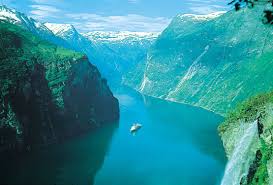Fjord:

A diesel fuel spill from a ship that sank recently spreads to the Greenland fjord.
- A fjord is a long, deep, narrow body of water that reaches far inland.
- Fjords are often set in a U-shaped valleywith steep walls of rock on either side.
- Fjords are found mainly in Norway, Chile, New Zealand, Canada, Greenland, and the U.S. state of Alaska
- Fjords have been shaped throughout the span of several ice ages by slow-moving glaciers.
- As the glacier moved, it cut away at the top layers of ice and into the sediment below.
- Melting waters also carved away into the land, meaning that many fjords are actually deeper than the sea that feeds into it.
- Where the fjord meets the sea, also known as the mouth, many glaciers left behind shill or shoal rock deposits.
- Because the mouth is a shallower opening than the body of the fjord, it results in extremely fast-moving water (this includes strong currents and saltwater rapids).
- Fjords commonly are deeper in their middle and upper reaches than at the seaward end.
- This results from the greater erosive power of the glaciers closer to their source, where they are moving most actively and vigorously.
- Because of the comparatively shallow thresholds of fjords, the bottoms of many have stagnant water and are rich in black mud containing hydrogen sulfide.
- Some features of fjords include coral reefsand rocky islands called skerries.




